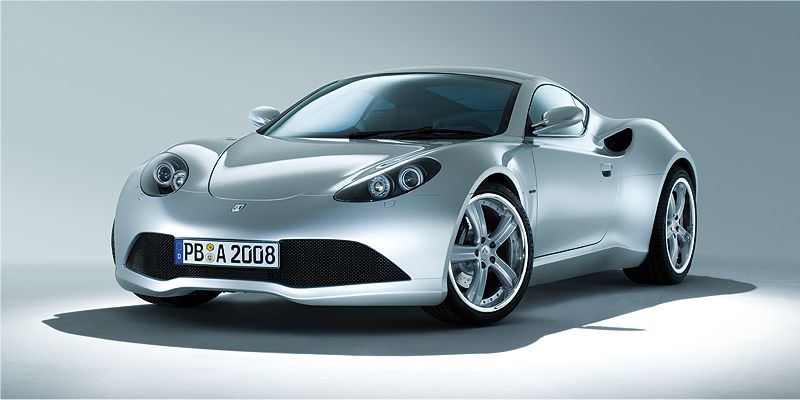In 2007, the automotive landscape witnessed the emergence of a remarkable newcomer — the Artega GT. This German-engineered sports car didn’t just enter the market; it redefined expectations for what a compact performance vehicle could achieve. With its mid-engine configuration and lightweight construction, the GT represented a bold statement from a fresh face in the industry.
The fusion of Henrik Fisker’s design prowess with German engineering precision created something extraordinary. While established manufacturers were pushing toward higher power outputs, Artega took a different approach — focusing on the power-to-weight ratio and driving dynamics that would set new standards in the sports car segment.
Engineering Excellence: The Heart of Performance
The Artega GT’s engineering story begins with its perfectly balanced powertrain — a VW-sourced 3.6-liter V6 engine delivering 300 horsepower at 6,600 rpm. This choice wasn’t about raw numbers; it was about achieving the perfect balance between power and control. The engine’s placement, nestled in the middle of the chassis, created an ideal weight distribution that would become the GT’s signature characteristic.
Fact!
The Artega GT's aluminum space frame and carbon fiber-reinforced body resulted in a remarkable weight of just 1,100 kg, making it one of the lightest sports cars in its class at the time.
“The Artega GT’s structural design represents a masterclass in automotive engineering,” notes Dr. Marcus Weber, former BMW chassis development engineer. “The combination of aluminum space frame and composite materials wasn’t just about weight reduction — it created a platform with exceptional torsional rigidity.”
The results speak for themselves: 0-100 km/h in under 5 seconds, achieved not through brute force but through intelligent engineering and weight optimization. This approach exemplified the company’s commitment to performance through sophistication rather than sheer power.
Design Legacy: Form Follows Function
Henrik Fisker’s design for the Artega GT showcases a masterful blend of aesthetics and aerodynamics. The compact dimensions — 3,950 mm in length and 1,880 mm in width — create a taut, purposeful stance that hints at the car’s sporting intentions.
“The GT’s design language speaks volumes about the evolution of sports car aesthetics,” remarks automotive design critic James Harrison. “Every curve serves a purpose, every line contributes to both visual appeal and aerodynamic efficiency.”
Key design elements that define the GT include:
- sculptured side panels that enhance airflow management;
- integrated rear diffuser for improved high-speed stability;
- compact front end optimized for weight distribution;
- distinctive greenhouse design maximizing visibility.
Important!
Unlike many contemporary sports cars that prioritized aggressive styling over function, the Artega GT's design elements all served specific performance purposes while maintaining visual harmony.
Performance Dynamics: The Driver’s Perspective
The true brilliance of the Artega GT reveals itself on the road. The mid-engine layout, coupled with the lightweight construction, creates a driving experience that’s both engaging and precise. The car’s compact dimensions and optimized weight distribution make it particularly adept at handling tight corners and challenging roads.
Professional racing driver Sarah Mitchell shares her experience: “What stands out about the GT is its exceptional balance. The car communicates clearly with the driver, providing feedback that inspires confidence at any speed. It’s a reminder that horsepower isn’t everything in sports car design.”
Market Impact and Legacy
The Artega GT emerged during a pivotal time in automotive history, when the industry was beginning to shift toward efficiency and environmental consciousness. Its approach to performance through lightweight construction and balanced design proved prescient, influencing subsequent sports car development.
Historical Reference!
The Artega GT's debut at the 2007 Geneva Motor Show marked the first time a new German sports car manufacturer had successfully launched a production-ready model in over two decades.
The car’s reception in the international press demonstrated the industry’s hunger for innovative approaches to sports car design. From Top Gear to Autoblog, critics praised not just the GT’s performance metrics but its holistic approach to the sports car formula.
Tomorrow’s Classic Today
The Artega GT represents more than just another entry in the sports car segment. It demonstrates how thoughtful engineering and design can create extraordinary performance without relying on excessive power or complexity. The car’s influence continues to resonate in modern sports car development.
This combination of innovation and tradition makes the Artega GT not just a remarkable achievement for its time, but a blueprint for future sports car development. Its legacy lives on in the principles it embodied: lightweight construction, balanced performance, and purposeful design.
Pros & Cons
| Advantages | Disadvantages |
|---|---|
| Exceptional power-to-weight ratio thanks to lightweight construction | Limited production numbers affecting parts availability |
| Superior handling characteristics due to mid-engine layout | Relatively modest power output compared to some competitors |
| Innovative aluminum and carbon fiber construction | Limited dealer network and support infrastructure |
| Distinctive Henrik Fisker design with practical aerodynamics | Higher maintenance costs due to specialized construction |
| Excellent build quality and German engineering precision | Less brand recognition compared to established manufacturers |
| Impressive performance without excessive power | Limited aftermarket support and modifications available |
| Compact dimensions ideal for both track and road use | Relatively high initial cost for the performance category |
The Artega GT remains a testament to the power of focused engineering and purposeful design. While it may not have achieved the commercial success of some mainstream sports cars, its influence on automotive design and engineering principles continues to resonate. The GT proves that innovation in the sports car segment doesn’t always require maximum power or cutting-edge technology — sometimes, it’s about finding the perfect balance of existing elements and executing them with precision.

